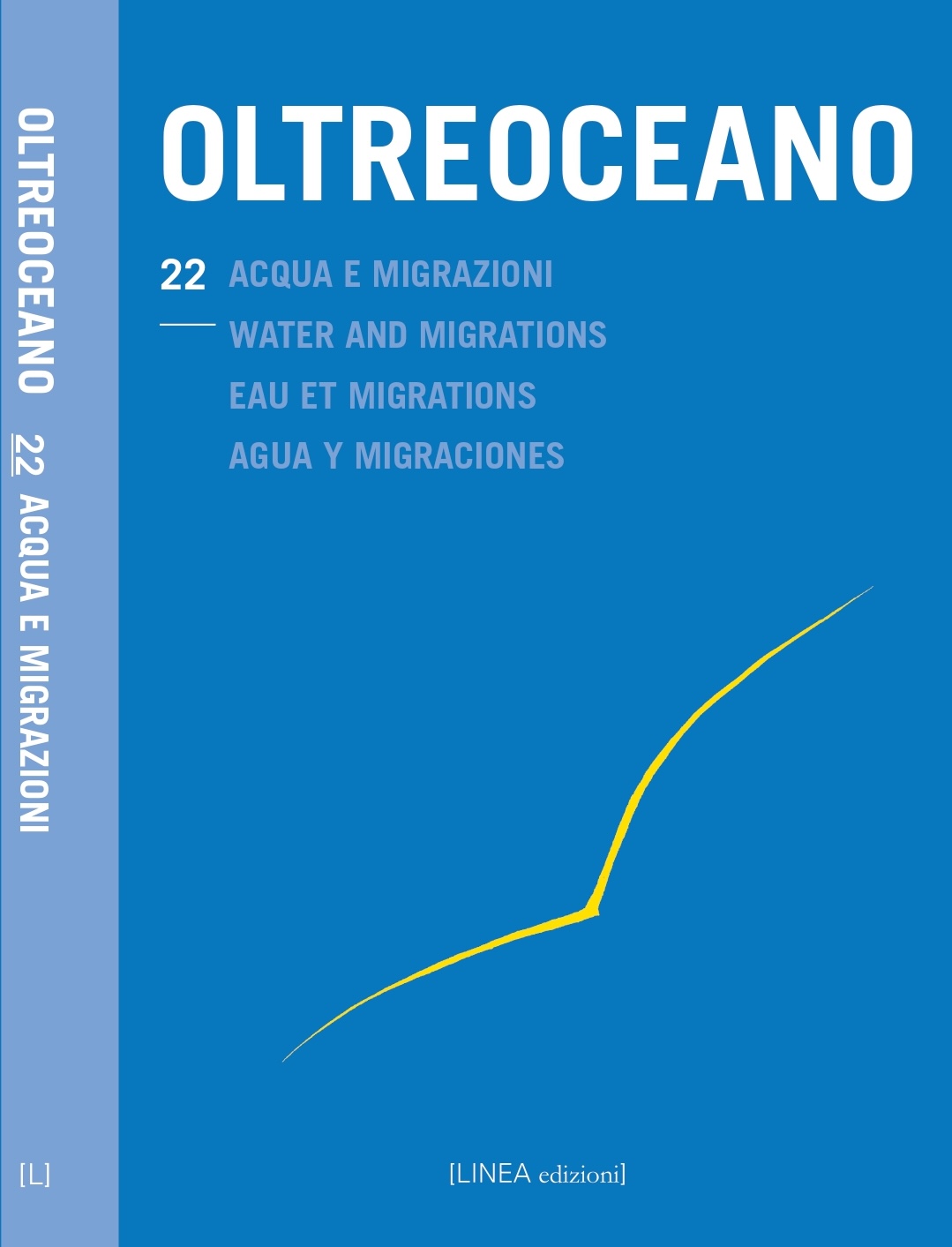Water as Vital Tears in Migrant Texts Overseas
DOI:
https://doi.org/10.53154/Oltreoceano76Keywords:
Water, Ocean, The Americas, Tears, LifeAbstract
This article examines the multiple meanings of water and its importance in literary texts. As a symbol of totality, where everything is possible, the ocean, in particular, links numerous aquatic mythologies which resort to mysterious dark seas and primordial waters as the world’s site of origin from the abyss of the night. Much travel literature is, indeed, inspired by the motifs of life, death and resurrection, by uncertainty, and by frightening monsters, ghost ships, mysterious marine beings both male and female, imaginary places both blissful and hellish, and treasure islands both lost and found. All these elements stimulate the individual to face the unknown and to abandon the inner abyss and the instability of solitude and misery so as to discover new realities and opportunities. The ocean thus has the ambivalent function to both separate and reunite, thanks to well-established routes that over time have intensified trade relations, territorial ambitions, scientific and technological discoveries, and general theories like Darwin’s. Even the Atlantic Ocean has been traversed by numerous voyages, despite having long been considered as the terror of sailors, the External Sea, the Sea of Darkness, and the impassible Surrounding Ocean before the revolutionary voyage of the three caravels in 1492. These voyages include those embarked on by many Italians who from the second half of the nineteenth century onwards set out in search of a new homeland filled with promises but also with obstacles to overcome before reaching the longed-for destination and being overcome by the anxieties of life. The Americas are thus a landing place replete with the hope for a better future and are distinguished by other waterways which irrigate their soil with more or less majestic waterfalls, big and small streams, and rivers that are either as big and tumultuous as oceans, or a peaceful and reassuring source of life for both the Indigenous peoples and the newcomers. This issue of Oltreoceano tackles all these aspects as it investigates different man- / woman-water approaches and explores what Neruda identifies as the potential polysemantic value of water as tears and as life.
Downloads
References
Borges, J. L. (1980): La busca de Averroes, 1949. In J. L. Borges, El Aleph. Prosa completa 2 (pp. 69 - 76). Parets del Valles (Barcelona): Bruguera.
Colón, C. (1982): Textos y documentos completos. Madrid: Alianza.
Eliade, M. (1993): Mito e realtà, 1962. G. Cantoni (Trad. e prefaz.). Roma: Borla.
Eliade, M. (1999): Il mito dell'eterno ritorno, 1949. G. Cantoni (Trad.). Roma: Borla.
Ferraro, A (2022): Écrire à l’intérieur de la “Frontière-Monde”. Oltreoceano, 20, pp. 15-17.
Gambaro, G. (2010): El mar que nos trajo. Buenos Aires: Norma.
Globalgeografia (2022): America del Nord e Centrale. Fiumi Principali. Recuperato da https://www.globalgeografia.com/america_del_nord/america_del_nord_fiumi.htm (Visitato il 9/11/2022).
Globalgeografia (2022a): America del Sud. Fiumi Principali. Recuperato da
https://www.globalgeografia.com/america_del_sud/america_del_sud_fiumi.htm (Visitato il 9/11/2022).
Milanesi, M. (1978): Introduzione. In G.B. Ramusio, Navigazioni e viaggi (pp. XI- XXXIX). M. Milanesi (Ed.). Torino: Einaudi.
Monod, T. (1980): Oceani. In Enciclopedia Einaudi 9 (pp. 956-996). Torino: Einaudi.
Neruda, P. (1970): Los ríos acuden. In P. Neruda, El canto general (p.14). D. Puccini (Ed.). Milano: Accademia.
Pivato J. (2023): North Atlantic:The Most Dangerous Water in the World. Oltreoceano, 22, in corso di stampa.
Downloads
Published
How to Cite
Issue
Section
License

This work is licensed under a Creative Commons Attribution-NonCommercial-ShareAlike 4.0 International License.
The authors undertake to comply with the following conditions, which are considered accepted at the time of submission of their contributions.
The sending of a text implies that it is unpublished and not submitted to be published elsewhere.
1. If accepted, the author shall confer on the publisher the right to publish and distribute it both in paper form and in the online electronic edition. The published articles will be downloadable and made available in open access.
2. Provided that it correctly indicates that the first publication took place in the journal Oltreoceano. Rivista sulle migrazioni the author has the right to: a) reproduce the article in separate extracts or collected in a volume; b) publish the article on their personal website or teaching site provided that these sites are of a non-commercial nature; c) deposit the article in online archives of a non-commercial nature, linked to the institution they belong to or as part of projects for the non-commercial dissemination and open access of scientific works.
The use of contributions by third parties, for commercial or otherwise unauthorized purposes, is not allowed. The publisher declines all responsibility for the unauthorized use of the material published in the journal.












